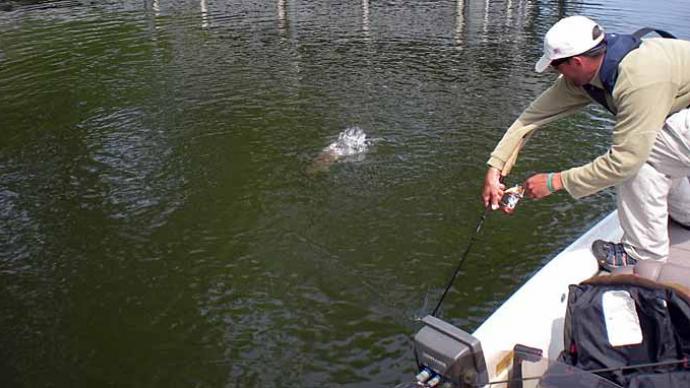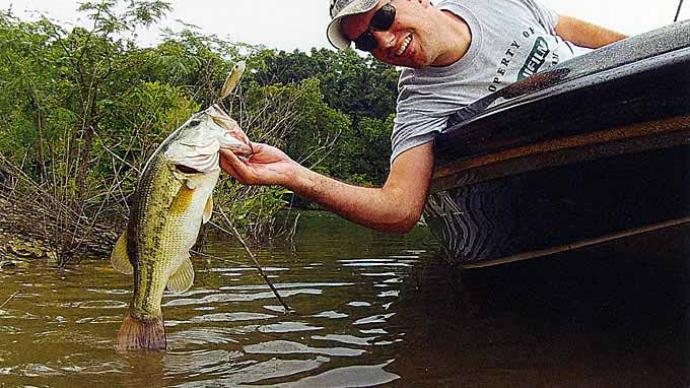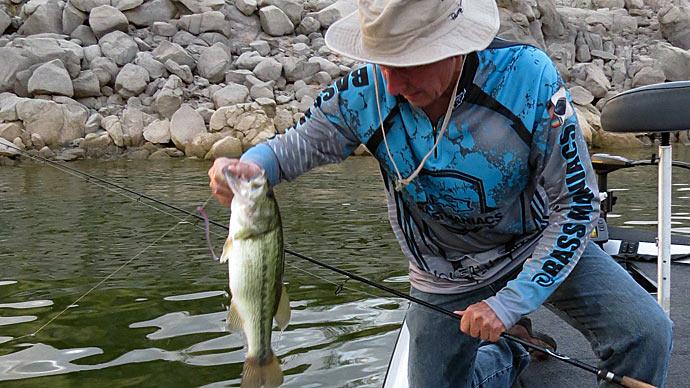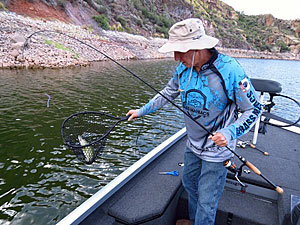
The drop shot and shaky head worm have made a lot of bass fishermen forget their old friend, the split shot rig, and that’s too bad. However, it could work out well for you if you pick one up — you’ll be doing something different, which often translates to more fish in the livewell.
Bass look for shade or deep water when the water warms. You can target either of these with a split shot rig. It also makes an excellent search bait: you can quickly cover a lot with a split shot rig. I’ve known fishermen to go down a bank with a split shot right after another guy and pull off fish the first guy missed. A split shot rig lets you cover a lot of territory and keep a finesse presentation that can trigger bites when the heat has made the fish sluggish.
Lake Pleasant is a mere 30 minutes north of Phoenix, with a population of over two million people. On summer weekends, it seems like every person in the valley is on the water. Nitro Boats Pro Gary Senft is from Arizona. He qualified for a Championship tournament in a large bass fishing circuit but was forced to pre-fish lake Pleasant on Labor Day weekend. “The boat traffic was beyond incredible,” Senft said. “I tried everything I could think of, including drop-shotting, but I couldn’t get bit.” What finally did produce for him was the humble split shot rig.
Where To Fish
Western lakes typically have few boat docks and almost no lily pads or other shore cover. Bass anglers fish at night or fish deep when the water warms up. Anglers rely heavily on depthfinders; the best start using their graphs before they even get on plane leaving the ramp.
In summer, they’re looking for the thermocline. This is the layer of water between the hotter water near the surface and the colder water near the bottom. On our deep Arizona reservoirs, depths of 200 feet plus are not unusual, but this very deep water is just as poor in oxygen as the hot water on the surface. Oxygen in the water is produced mainly by microscopic plants, and they can’t live in the dark.

However, there can be light as deep as 40 feet or more in these crystal clear waters and, therefore, oxygen. The thermocline shows up as a band on the depthfinder and anglers like Senft target areas with structure that intersects the thermocline. A good paper map or a good map on your graph will help you quickly pinpoint productive areas.
With a drop-shot rig, the worm is fixed above the weight. This is a definite plus when weeds or debris are on the bottom because it holds the worm above potential snags. This is also a dynamite way to target suspended fish or fish stacked up very tight to structure.
But a split shot rig is different.
The worm behind a split shot rig is free to dip and float. Pull the line a bit, and it will dart forward. Hold the line still, and the worm will slowly zigzag toward the bottom. Like its big brother, the Carolina rig, the split shot rig is ideal for covering water, albeit at a much slower pace, and when you stop moving it, the enticement of that drifting worm is often more than even a sluggish bass can resist.
Labor Day in central Arizona means temperatures well over 110 degrees in the shade. During Labor Day weekend, Senft typically finds fish shallower than you might expect. The unrelenting heat, boat traffic, and fishing pressure hadn’t driven the bass deeper; the fish simply had lockjaw. He was dragging a split-shot rig down a point, focused on fishing when he discovered that the fish were simply picking the bait up and staying still. When the rig would move, the split-shot would come up off the bottom and not go back down. It was just swinging there.
He tugged the line just a little, and suddenly the fish turned and ran for it. Detecting bites is a primary key to successful fishing with any lure. You need to pay strict attention to what the bait is doing at all times. Bass fishing pro Ricky Clunn calls it “Being in the zone.” Average fishermen probably miss dozens of bites a day. Big bass suck in a lure and quickly spit it back out. By the time the hook is set, the fish is long gone. Training yourself to detect those bites is vital.
How To Rig
There are many ways to tie a split shot rig. The fastest way is to crimp a round split shot onto your line simply – hence the name. However, those removable ones with the ears will give you a line twist that will make you want to rip your hair out, and all split shots squeeze and potentially damage your line. The light line on a split shot rig can easily break if damaged. Crimping the weight isn’t the best way to go about it.
An alternative is using a mojo weight, and a rubber nail. The rubber nail is threaded through the sinker and pulled tight until it keeps the sinker snugly in place on the line. This rig is also adjustable: simply by pulling the weight along the line, you can change the length of your leader. You can also make a mini Carolina rig with a very light swivel and a light weight. This setup reduces line twists.

Terminal tackle is crucial. The hook needs to be fine and very sharp, able to penetrate and hold even when the hookset is nothing more than steady pressure. Choose hooks in sizes 1, 1/0, and 2/0, sized to the bait you’re using. Senft swears by Rebarb hooks because they are fine and sharp, and that little ear by the eye keeps even soft Roboworms and Yamamoto worms on. You need a larger hook with a larger bait to have plenty of bite. Since you usually have a lot of line out when you’re split shotting, you need a reasonably stiff rod with a fast tip, or you can’t set the hook. Your spinning reel needs to take up a lot of line quickly, and a good drag is essential. The line itself needs some stretch, but not too much. The fluorocarbon line is excellent for split-shot rigs. It lets you quickly set the hook, and the fish can’t see it – it’s the perfect stuff for finesse techniques.
You can start fishing for a more aggressive bite when you first tie up a split shot rig. Use a heavier shot and fish at a steady pace. A good breeze usually means the bite will be a little better, and you can just let the wind push you along. During a dead-calm day on a lake full of fish with lockjaw, lighten up the weight and move the bait as slowly as possible, just one to three inches at a time. Between those two extremes, there are a variety of speeds and retrieves that will catch fish. Somewhere from fast to excruciatingly slow, you’ll start catching fish. Stick with that retrieve until it quits working.
Gregg Warne taught me to fish a split shot rig many years ago, and one of my questions was about leader length. How much line should there be between the hook and the weight? When fishing in water 15 feet deep or less, or when the fish are right on the bottom, Gregg would leave about a foot between the hook and the split-shot.
If the fish were a bit off the bottom or fishing more than 20 feet deep, he would put the split-shot around 18 inches from the bait. When things get tough — like when the fish are suspended, or a front had just moved through, he would use a leader as long as two or three feet. The bait rises as you move the rig. Then it starts to sink when you stop moving slowly. The more challenging the bite, the slower you want the bait to sink. It might take him three hours to go 100 yards in really tough times!
Floaters
Split-shotting a floating worm gives your presentation a completely different action. Instead of slowly settling to the bottom, a floater darts forward when you move the rig, then bounces back up when you stop. Then it hangs there, moved subtly back and forth by water currents. If you’re fishing rocks or mud and your weight is sinking below what the fish perceives as the bottom, a floating worm will be floating above the bottom where fish can see it. Super floaters and plastics like Strike King’s 3X Floating Worms should be part of your split shot arsenal.
How To Fish The Split Shot
Casting a split shot rig out is a great way to get snagged constantly. There’s a better way. With the drag set tight, drop (don’t cast) the split-shot rig over the side, let it fall to the bottom on its own, and use the boat to move it along. This seems to result in fewer hang-ups and snags than casting does. Sometimes casting is necessary, but try to make short casts and let the rig follow you around. The key is keeping the split-shot in contact with the bottom, so you must be aware when climbing over a submerged rock or tree, etc. You will need to make constant adjustments on line, letting it out, reeling it in – you want to keep the line taut so you can feel what is going on, and you want to keep the weight on the bottom.
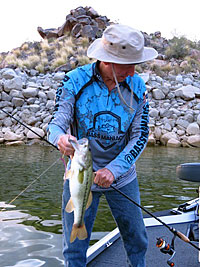
Loosely hold the rod and point the rod tip at the bait. If you hold the rod too tight, the fish will feel pressure as soon as a bite takes place. Warne would let the rod almost dangle from his fingers, and he concentrates on feeling the rig through the rod. A great rod is vital.
I use a Dobyns Rod to fish the split shot rig. It is a light and strong rod so you can fish all day without getting tired, and transmits every slight vibration to your hand. When you detect a bite, whether from weight or lack of weight, let the fish run with it for a few seconds, then set the hook by sweeping the rod sideways all the way around until it's pointing behind you, reeling all the while.
Sweeping the rod this way gives you two entire rod lengths of hookset. This is plenty to take up the slack line and get a sharp hook into the fish, especially since you’re reeling the whole time. Once you get the fish on, keep steady pressure on it. After the initial set, Gregg often loosened the drag up a bit, especially on a bigger fish.
Once you’ve got that fish coming at you, don’t let up or start switching the rod from side to side because that’s when you’ll lose him. Keep the fish coming in the same direction until you’ve got him in. Don’t give that hook a chance to fall out or work loose. It isn’t unusual to sweep a big split shot fish into the net and have the hook fall out right then and there. Netting, by the way, is a good idea. Light line and small hooks make swinging a fish into the boat risky.
Split-shotting is a tight-line finesse technique. Use the lightest weight you can get away with — just enough to keep the weight on the bottom. Contact with the bottom is critical to success because that’s how you feel pick-ups and bites. With a split-shot rig, you do not want commotion. You want subtle. Keep the weight as small as possible, but keep your line taut so you can feel what is going on.
Summer or Winter
The split shot rig produces in tough conditions that shut the fish down, whether it's heat or cold. Gary, even fishes, split shot rigs on vertical walls. “I throw it right against the wall and just feed out line until it hits bottom on the first ledge,” Senft said. “Then I let it sit there, and I imagine that worm slowly settling to the bottom. It takes about six seconds. Then I pull very softly until I feel it drop over the edge of the ledge and feed it line until it gets to the next level. There’s no bite at all. I feel heaviness when I go to pull it after letting the worm settle.”
When the bite is tough, people start to get desperate, and they tend to go faster without really meaning to, trying to find and catch some fish. What they need to do is slow down. A split-shot rig is perfect for those times. Being good at split shotting takes concentration and skill, and that pays off by improving your overall fishing prowess. That fact alone is reason enough to try it.
BassResource may receive a portion of revenues if you make a purchase using a link above.


